Hippopotamus
| Hippopotamus Temporal range:
| |
|---|---|
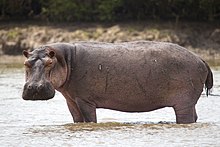
| |
| A hippopotamus inSaadani National Park,Tanzania | |
| Scientific classification | |
| Domain: | Eukaryota |
| Kingdom: | Animalia |
| Phylum: | Chordata |
| Class: | Mammalia |
| Order: | Artiodactyla |
| Family: | Hippopotamidae |
| Genus: | Hippopotamus |
| Species: | H. amphibius
|
| Binomial name | |
| Hippopotamus amphibius | |
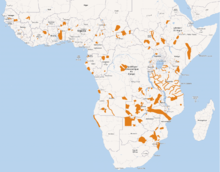
| |
| Current distribution of the hippopotamus | |
Thehippopotamus(Hippopotamus amphibius) (/ˌhɪpəˈpɒtəməs/;pl.:hippopotamuses;also shortened tohippo(pl.:hippos), further qualified as thecommon hippopotamus,Nile hippopotamus,orriver hippopotamus,is a largesemiaquaticmammal native tosub-Saharan Africa.It is one of only twoextantspeciesin thefamilyHippopotamidae,the other being thepygmy hippopotamus(Choeropsis liberiensisorHexaprotodon liberiensis). Its name comes from theancient Greekfor "river horse" (ἱπποπόταμος).
Afterelephantsandrhinoceroses,the hippopotamus is the nextlargest land mammal.It is also the largest extant landartiodactyl.Despite their physical resemblance topigsand other terrestrial even-toed ungulates, the closest living relatives of the hippopotamids arecetaceans(whales,dolphins,porpoises,etc.), from which they diverged about 55 million years ago. Hippos are recognisable for their barrel-shaped torsos, wide-opening mouths with largecaninetusks, nearly hairless bodies, pillar-like legs, and large size: adults average 1,500 kg (3,300 lb) for bulls (males) and 1,300 kg (2,900 lb) for cows (females). Despite its stocky shape and short legs, it is capable of running 30 km/h (19 mph) over short distances.
Hippos inhabit rivers, lakes, andmangroveswamps.Territorialbulls each preside over a stretch of water and a group of five to thirty cows and calves.Matingand birth both occur in the water. During the day, hippos remain cool by staying in water or mud, emerging at dusk to graze on grasses. While hippos rest near each other in the water, grazing is a solitary activity and hippos typically do not display territorial behaviour on land. Hippos are among the most dangerous animals in the world due to their aggressive and unpredictable nature. They are threatened byhabitat lossandpoachingfor their meat andivory(canine teeth).
Etymology
TheLatinwordhippopotamusis derived from the ancientGreekἱπποπόταμος(hippopótamos), fromἵππος(híppos)'horse'andποταμός(potamós)'river',together meaning'horse of the river'.[3][4][5]In English, thepluralis "hippopotamuses".[6]
Taxonomy and origins
Classification
The modern hippopotamus and thepygmy hippopotamusare the only living members of the family Hippopotamidae. Some taxonomists place hippos andanthracotheresin the superfamily Anthracotheroidea. Hippopotamidae are classified along with othereven-toed ungulatesin theorderArtiodactyla.[7]: 39–40
Five subspecies of hippos have been described based onmorphologicaldifferences in their skulls as well as differences in geographical range:[7]: 3 [8][9][10]
- H. a. amphibius– (the nominate subspecies) ranges fromGambiaeast toEthiopiaand then south toMozambiqueand historically ranged as far north as Egypt; its skull is distinguished by a moderately reduced preorbital region, a bulging dorsal surface, elongatedmandibular symphysisand larger chewing teeth.
- H. a. kiboko– found inKenyaandSomalia;was noted to be smaller and more lightly coloured than other hippos with wider nostrils, somewhat longer snout and more rounded and relatively raisedorbitswith the space between them being incurved.
- H. a. capensis– found inZambiaandSouth Africa;distinguished by wider orbits.
- H. a. tschadensis– ranges betweenChadandNiger;featured a slightly shorter but broader face, and pronounced, forward-facing orbits.
- H. a. constrictus– ranged from the southernDemocratic Republic of CongotoAngolaandNamibia;skull characterised by a thicker preorbital region, shorter snout, flatter dorsal surface, reduced mandibular symphysis and smaller chewing teeth.
The suggested subspecies above were never widely used or validated by field biologists; the described morphological differences were small enough that they could have resulted from simple variation in nonrepresentative samples.[7]: 2 A study examiningmitochondrial DNAfrom skin biopsies taken from 13 sampling locations found "low, but significant, genetic differentiation" amongH. a. amphibius,H. a. capensis,andH. a. kiboko.NeitherH. a. tschadensisnorH. a. constrictushave been tested.[9]
Evolution

Until 1909,naturalistsclassified hippos together with pigs based onmolarpatterns. Several lines of evidence, first from blood proteins, then frommolecular systematics,[12]DNA[13][14]and thefossil record,show their closest living relatives arecetaceans(whales,dolphins,andporpoises).[15][16]The common ancestor of hippos and whales branched off fromRuminantiaand the rest of the even-toed ungulates; the cetacean and hippo lineages split soon afterwards.[13][16]

The most recent theory of the origins of Hippopotamidae suggests hippos and whales shared a common semiaquatic ancestor that branched off from other artiodactyls around60million years ago.[13][15]This hypothesised ancestral group likely split into two branches again around54million years ago.[12]
One branch wouldevolve into cetaceans,possibly beginning about52million years ago,with the protowhalePakicetusand other early whale ancestors collectively known asArchaeoceti.This group eventually underwentaquatic adaptationinto the completely aquaticcetaceans.[16]The other branch became theanthracotheres,a large family of four-legged beasts, the earliest of which in the lateEocenewould have resembled skinny hippos with comparatively smaller, narrower heads. All branches of the anthracotheres, except that which evolved intoHippopotamidae,became extinct during thePliocene,leaving no descendants.[15][16]
A rough evolutionary lineage of the hippo can thus be traced from Eocene andOligocenespecies: fromAnthracotheriumandElomeryxto theMiocenespeciesMerycopotamusandLibycosaurusand finally the very latest anthracotheres in thePliocene.[17]These groups lived across Eurasia and Africa. The discovery ofEpirigenysin East Africa, which was likely a descent of Asian anthracotheres and asister taxonto Hippopotamidae, suggests that hippo ancestors entered Africa from Asia around35million years ago.[18][19]An early hippopotamid is the genusKenyapotamus,which lived in Africa from 15 to9million years ago.[17]Hippopotamid species would spread across Africa and Eurasia, including the modern pygmy hippo. From 7.5 to1.8million years ago,a possible ancestor to the modern hippo,Archaeopotamus,lived in Africa and the Middle East.[20]The oldest records of the genusHippopotamusdate to thePliocene(5.3-2.6 million years ago).[21]The oldest unambiguous records of the modernH. amphibiusdate to theMiddle Pleistocene,though there are possibleEarly Pleistocenerecords.[22]

Extinct species
Three species ofMalagasy hippopotamusbecame extinct during theHoloceneonMadagascar,the last of them within the past 1,000 years. The Malagasy hippos were smaller than the modern hippo, a likely result of the process ofinsular dwarfism.[23]Fossil evidence indicates many Malagasy hippos were hunted by humans, a factor in their eventual extinction.[23]Isolated individual Malagasy hippos may have survived in remote pockets; in 1976, villagers described a living animal called thekilopilopitsofy,which may have been a Malagasy hippo.[24]
Hippopotamus gorgopsfrom the Early Pleistocene-early Middle Pleistocene of Africa and West Asia grew considerably larger than the living hippopotamus, with an estimated body mass of over 4,000 kg (8,800 lb).[21][25][26]Hippopotamus antiquusranged throughout Europe, extending as far north as Britain during theEarlyandMiddle Pleistoceneepochs, before being replaced by the modernH. amphibiusin Europe during the latter part of the Middle Pleistocene.[27]The Pleistocene also saw a number of dwarf species evolve on several Mediterranean islands, includingCrete(Hippopotamus creutzburgi),Cyprus(theCyprus dwarf hippopotamus,Hippopotamus minor),Malta(Hippopotamus melitensis), andSicily(Hippopotamus pentlandi). Of these, the Cyprus dwarf hippo survived until the end of the Pleistocene or early Holocene. Evidence from the archaeological siteAetokremnoscontinues to cause debate on whether or not the species was driven to extinction or even encountered by human.[28][29]
Characteristics
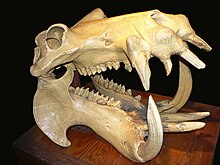
The hippopotamus is amegaherbivoreand is exceeded in size among land animals only byelephantsand somerhinocerosspecies. The mean adult weight is around 1,480 kg (3,260 lb) for bulls and 1,365 kg (3,009 lb) for cows. Exceptionally large males have been recorded reaching 2,660 kg (5,860 lb).[30]Male hippos appear to continue growing throughout their lives, while females reach maximum weight at around age 25.[31]It is 2.90 to 5.05 m (9 ft 6 in to 16 ft 7 in) long,[32]including a tail of about 35 to 56 cm (14 to 22 in) in length and 1.30 to 1.65 m (4 ft 3 in to 5 ft 5 in) tall at the shoulder,[33][34]with males and females ranging 1.40 to 1.65 m (4 ft 7 in to 5 ft 5 in) and 1.30 to 1.45 m (4 ft 3 in to 4 ft 9 in) tall at the shoulder respectively.[34]The species has a typical head-body length of 3.3–3.45 m (10.8–11.3 ft) and an average standing height of 1.4 m (4 ft 7 in) at the shoulder.[35]
Hippos have barrel-shaped bodies with short tails and legs, and an hourglass-shaped skull with a long snout.[36][7]: 3, 19 Their skeletal structures aregraviportal,adapted to carrying their enormous weight,[7]: 8 and their dense bones and lowcentre of gravityallows them to sink and move along the bottom of the water.[37]Hippopotamuses have small legs (relative to othermegafauna) because the water in which they live reduces the weight burden.[38]The toes are webbed and thepelvisrests at an angle of 45 degrees.[7]: 3, 9 Though chubby-looking, hippos have little fat.[7]: 3 The eyes, ears, and nostrils of hippos are placed high on the roof of their skulls. This allows these organs to remain above the surface while the rest of the body is submerged.[39]: 259 The nostrils and ears can close when underwater whilenictitating membranescover the eyes.[7]: 4, 116 Thevocal foldsof the hippo are more horizontally positioned, much like cetaceans. Underneath are throat tissues, where vibrations are transmitted to produce underwater calls.[40]

The hippo's jaw is powered by hugemasseteranddigastric muscleswhich give them large, droopy cheeks.[39]: 259 The jaw hinge allows the animal to open its mouth at almost 180°.[7]: 17 A foldedorbicularis oris muscleallows the hippo to attain an extreme gape without tearing any tissue.[41]On the lower jaw, theincisorsandcaninesgrow continuously, the former reaching 40 cm (16 in), while the latter can grow to up to 50 cm (20 in). The lower canines are sharpened through contact with the smaller upper canines.[36]The canines and incisors are used mainly for combat instead of feeding. Hippos rely on their flattened, horny lips to grasp and pull grasses which are then ground by themolars.[39]: 259, 263 The hippo is considered to be apseudoruminant;it has a complex three-chambered stomach, but does not "chewcud".[7]: 22

Hippo skin is 6 cm (2.4 in) thick across much of its body with little hair.[36][39]: 260 The animal is mostly purplish-grey or blue-black, but brownish-pink on the underside and around the eyes and ears.[39]: 260 Their skin secretes a natural, red-colouredsunscreensubstance that is sometimes referred to as "blood sweat" but is neither blood nor sweat. This secretion is initially colourless and turns red-orange within minutes, eventually becoming brown. Two highly acidic pigments have been identified in the secretions; one redhipposudoric acidand one orange norhipposudoric acid, which inhibit the growth of disease-causing bacteria and their light-absorption profile peaks in theultravioletrange, creating a sunscreen effect.[42][43]Regardless of diet, all hippos secrete these pigments so food does not appear to be their source; rather, they may be synthesised fromprecursorssuch as theamino acidtyrosine.[43]This natural sunscreen cannot prevent the animal's skin from cracking if it stays out of water too long.[44]
The testes of the males do not fully descend and a scrotum is not present. In addition, the penis retracts into the body when noterect.The genitals of the female hippos are unusual in that the vagina is ridged and thevulval vestibulehas two large, protrudingdiverticula.Both of these have an unknown function.[7]: 28–29
A hippo's lifespan is typically 40 to 50 years.[39]: 277 Donna the Hippo was one of the oldest living hippos in captivity. She lived at theMesker Park ZooinEvansville, Indiana,in the US[45][46]until her death in 2012 at the age of 61.[47]The oldest hippo ever recorded was called Bertha; she had lived in theManila Zooin the Philippines since it first opened in 1959. When she died in 2017, her age was estimated to be 65.[48]The oldest living hippopotamus in captivity is Lu the Hippo, from the Ellie SchillerHomosassa Springs Wildlife State Park.As of 2024, he is 64 years old.[49]
Distribution and status


Hippopotamus amphibiusarrived in Europe around 560-460,000 years ago, during the Middle Pleistocene.[50]The distribution ofHippopotamus amphibiusin Europe during the Pleistocene was largely confined to Southern Europe, including the Iberian Peninsula,[51]Italy,[52][53]and Greece,[54]but extended into northwestern Europe, including Great Britain (as far north asNorth Yorkshire), the Netherlands, and western Germany duringinterglacialperiods, such as theLast Interglacial(130–115,000 years ago).[55][56][57]The youngest records of the species in Europe are from the Late Pleistocene of Greece, dating to around 40-30,000 years ago.[54][51]
Archaeological evidence exists of its presence in theLevant,dating to less than 3,000 years ago.[58][59]The species was common inEgypt'sNileregion duringantiquity,but it has since been driven out. According toPliny the Elder,in his time, the best location in Egypt for capturing this animal was in theSaite nome;[60]the animal could still be found along theDamiettabranch of the Nile after the Arab Conquest in 639. Reports of the slaughter of the last hippo inNatal Provincewere made at the end of the 19th century.[61]Hippos are still found in the rivers and lakes of the northernDemocratic Republic of the Congo,Uganda,Tanzania,andKenya,north through toEthiopia,Somalia,andSudan,west toThe Gambia,and south toSouth Africa.[1]
Genetic evidence suggests common hippos in Africa experienced a marked population expansion during or after thePleistocene,attributed to an increase in water bodies at the end of the era. These findings have important conservation implications, as hippo populations across the continent are currently threatened by loss of access to fresh water.[9]Hippos are also subject to unregulated hunting andpoaching.The species is included in Appendix II of theConvention on International Trade in Endangered Species(CITES) meaning international export/import (including in parts and derivatives) requires CITES documentation to be obtained and presented to border authorities.[1][62]
As of 2017, theIUCN Red Listdrawn up by theInternational Union for Conservation of Nature(IUCN) lists the species asvulnerable,with a stable population estimated between 115,000 and 130,000 animals.[1]The hippo population has declined most dramatically in the Democratic Republic of the Congo.[63]By 2005, the population inVirunga National Parkhad dropped to 800 or 900 from around 29,000 in the mid-1970s.[64]This decline is attributed to the disruptions caused by theSecond Congo War.[64]The poachers are believed to beMai-Mairebels, underpaid Congolese soldiers, and local militia groups.[64][65]Reasons for poaching include the belief hippos are harmful to society, as well as financial gain.[66]As of 2016, the Virunga hippo population appears to have increased again, possibly due to better protection from park rangers, who have worked with local fishermen.[67]The sale of hippo meat is illegal, but black-market sales are difficult for Virunga National Park officers to track.[65][66]Hippo meat is highly valued in some areas of central Africa and the teeth may be used as a replacement for elephant ivory.[68]
A population of hipposexists in Colombia,descended from captive individuals that escaped fromPablo Escobar's estate after his death in 1993. Their numbers grew to 100 by the 2020s and ecologists believe the population should be eradicated, as they are breeding rapidly and are an increasing menace to humans and the environment. Attempts to control them include sterilisation andculling.[69]
Behaviour and ecology
Hippos aresemiaquaticand require enough water to immerse in, while being close to grass.[36]They mostly live in freshwater habitat, but can be found inestuaries.[1]They prefer relatively still waters with gently sloping shores, though male hippos may also be found in very small numbers in morerapidwaters with rocky slopes.[39]: 264 Like most herbivores, hippos will consume a variety of plants if presented with them in captivity, but their diet in nature consists almost entirely of grass, with only minimal consumption of aquatic plants.[70]Hippos spend most of the day in water to stay cool and hydrated. Just before night begins, they leave the water to forage on land. A hippo will travel 3–5 km (1.9–3.1 mi) per night, eating around 40 kg (88 lb) of grass. By dawn, they are back in the water.[36]
Despite being semiaquatic, an adult hippo is not a particularly good swimmer, nor can it float. It rarely enters deep water; when it does, the animal moves by bouncing off the bottom. An adult hippo surfaces every four to six minutes, while young need to breathe every two to three minutes.[7]: 3–4 Hippos move on land bytrotting,and limb movements do not change between speeds. They can reach an airborne stage (a stage when all limb are off the ground) when they move fast enough. Hippos are reported to reach 30 km/h (19 mph) but this has not been confirmed.[71]They are incapable of jumping but can walk up steep banks.[36]The hippopotamus sleeps with both hemispheres of the brain resting, as in all land mammals, and usually sleeps on land or in water with the nostrils exposed. Despite this, it may be capable of sleeping while submerged, intermittently surfacing to breathe without waking. They appear to transition between different phases of sleep more quickly than other mammals.[72]
Because of their size and their habit of taking the same paths to feed, hippos can have a significant impact on the land across which they walk, keeping the land clear of vegetation and depressing the ground. Over prolonged periods, hippos can divert the paths of swamps and channels.[73]By defecating in the water, the animals also appear to pass on microbes from their gut, affecting thebiogeochemical cycle.[74]On occasion, hippos have been filmed eatingcarrion,usually near the water. There are other reports of meat-eating and evencannibalismandpredation.[75]Hippos' stomach anatomy lacks adaptions to carnivory and meat-eating is likely caused by lack of nutrients or just an abnormal behaviour.[7]: 82–84
Social life
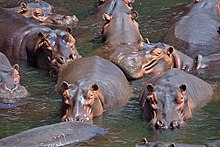
It is challenging to study the interaction of bulls and cows because hippos are notsexually dimorphic,so cows and young bulls are almost indistinguishable in the field.[76]Hippo pods fluctuate but can contain over 100 hippos. Although they lie close together, adults develop almost no social bonds. Males establishterritoriesin water but not land, and these may range 250–500 m (820–1,640 ft) in lakes and 50–100 m (160–330 ft) in rivers. Territories are abandoned when the water dries up. The bull has breeding access to all the cows in his territory. Younger bachelors are allowed to stay as long as they defer to him. A younger male may challenge the old bull for control of the territory. Within the pods, the hippos tend to segregate by sex and status. Bachelor males lounge near other bachelors, females with other females, and the territorial male is on his own. When hippos emerge from the water to graze, they do so individually.[7]: 4–5, 49–50

Hippos engage in "muck-spreading" which involves defecating while spinning their tails to distribute the faeces over a greater area. Muck-spreading occurs both on land and in water and its function is not well understood. It is unlikely to serve a territorial function, as the animals only establish territories in the water. They may be used as trails between the water and grazing areas.[7]: 5, 51–52 "Yawning" serves as a threat display.[36]When fighting, bulls use their incisors to block each other's attacks and their large canines as offensive weapons.[39]: 259–260 When hippos become over-populated or a habitat shrinks, bulls sometimes attemptinfanticide,but this behaviour is not common under normal conditions.[77]
The most common hippo vocalisation is the "wheeze honk", which can travel over long distances in air.[78]This call starts as a high-pitched squeal followed by a deeper, resonant call.[7]: 5 The animals can recognise the calls of other individuals. Hippos are more likely to react to the wheeze honks of strangers than to those they are more familiar with.[78]When threatened or alarmed, they produce exhalations,[36]and fighting bulls will bellow loudly.[7]: 5 Hippos are recorded to produce clicks underwater which may haveecholocativeproperties.[79]They have the unique ability to hold their heads partially above the water and send out a cry that travels through both water and air; individuals respond both above and below water.[80]
Reproduction
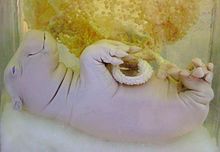
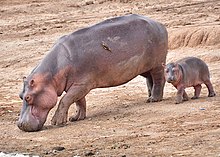
Cows reach sexual maturity at five to six years of age and have agestation periodof eight months.[81]A study ofendocrine systemsrevealed cows may begin puberty at as early as three or four years.[82]Bulls reach maturity at around 7.5 years. Both conceptions and births are highest during thewet season.Male hippos always have mobilespermatozoaand can breed year-round.[7]: 59–61, 66 After becoming pregnant, a female hippo will typically not begin ovulation again for 17 months.[82]Hippos mate in the water, with the cow remaining under the surface,[7]: 63 her head emerging periodically to draw breath. Cows give birth in seclusion and return within 10 to 14 days. Calves are born on land or shallow water[36]weighing on average 50 kg (110 lb) and at an average length of around 127 cm (50 in). The female lies on her side when nursing, which can occur underwater or on land. The young are carried on their mothers' backs in deep water.[7]: 4, 64
Mother hippos are very protective of their young, not allowing others to get too close.[36]One cow was recorded protecting a calf's carcass after it had died.[83]Calves may be temporarily kept innurseries,guarded by one or more adults, and will play amongst themselves.[36]Like many other large mammals, hippos are described asK-strategists,in this case typically producing just one large, well-developed infant every couple of years (rather than many small, poorly developed young several times per year, as is common among small mammals such as rodents).[82][77]Calves no longer need to suckle when they are a year old.[7]: 64
Interspecies interactions
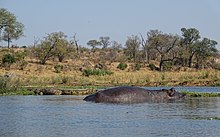
Hippos coexist alongside a variety of large predators in their habitats.Nile crocodiles,lions,andspotted hyenasare known to prey on young hippos.[36]Beyond these, adult hippos are not usually preyed upon by other animals due to their aggression and size. Cases where large lion prides have successfully preyed on adult hippos have been reported, but it is generally rare.[84]Lions occasionally prey on adults atGorongosa National Parkand calves are sometimes taken at Virunga.[85]Crocodilesare frequent targets of hippo aggression, probably because they often inhabit the sameriparianhabitats; crocodiles may be either aggressively displaced or killed by hippos.[86]In turn, very large Nile crocodiles have been observed preying occasionally on calves, "half-grown" hippos, and possibly also adult female hippos. Groups of crocodiles have also been observed finishing off still-living male hippos that were previously injured in mating battles with other males.[87][88]
Hippos occasionally visitcleaning stationsin order to be cleaned of parasites by certain species of fishes. They signal their readiness for this service by opening their mouths wide. This is an example ofmutualism,in which the hippo benefits from the cleaning while the fish receive food.[89]Hippo defecation createsallochthonousdeposits of organic matter along the river beds. These deposits have an unclear ecological function.[70]A 2015 study concluded hippo dung provides nutrients from terrestrial material for fish and aquatic invertebrates,[90]while a 2018 study found that their dung can be toxic to aquatic life in large quantities, due to absorption of dissolved oxygen in water bodies.[91][92]
The parasiticmonogeneanflatwormOculotrema hippopotamiinfests hippopotamus eyes, mainly the nictitating membrane. It is the only monogenean species (which normally live on fish) documented to live on a mammal.[93]
Hippos and humans
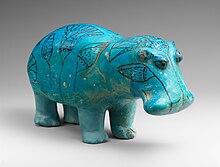
Cut marks on bones ofH. amphibiusfound atBolomor Cave,a site in Spain preserving fossils dating from 230,000 to 120,000 years ago, provides evidence forNeanderthalbutchery of hippopotamuses.[94][95]The earliest evidence of modern human interaction with hippos comes from butchery cut marks on hippo bones found at theBouri Formationand dated to around 160,000 years ago.[96]4,000–5,000 year art showing hippos being hunted have been found in theTassili n'Ajjer Mountainsof the centralSaharanearDjanet.[7]: 1 Theancient Egyptiansrecognised the hippo as ferocious, and representations on the tombs of nobles show humans hunting them.[97]
The hippo was also known to theGreeksandRomans.The Greek historianHerodotusdescribed the hippo inThe Histories(writtencirca440 BC) and the Roman naturalistPliny the Elderwrote about the hippo in his encyclopediaNaturalis Historia(writtencirca77 AD).[60][98]TheYoruba peoplecalled the hippoerinmi,which means "elephant of the water".[99]Some individual hippos have achieved international fame.Hubertabecame a celebrity during the Great Depression for trekking a great distance acrossSouth Africa.[100][101]: 111–112
Attacks on humans
The hippo is considered to be extremely aggressive and has frequently been reported charging and attacking boats.[102]Small boats can easily be capsized by hippos and passengers can be injured or killed by the animals, or drown in the water. In one 2014 case inNiger,a boat was capsized by a hippo and 13 people were killed.[103]Hippos will often raid farm crops if the opportunity arises, and humans may come into conflict with them on these occasions. These encounters can be fatal to either humans or hippos.[104]
According to thePtolemaichistorianManetho,thepharaohMeneswas carried off and then killed by a hippopotamus.[105]
In zoos
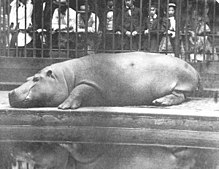
Hippos have long been popular zoo animals. The first record of hippos taken into captivity for display is dated to 3500 BC in Hierakonpolis, Egypt.[106]The first zoo hippo in modern history wasObaysch,who arrived at theLondon Zooon 25 May 1850, where he attracted up to 10,000 visitors a day and inspired a popular song, the "Hippopotamus Polka".[107]
Hippos generally breed well in captivity; birth rates are lower than in the wild, but this can be attributed to zoos' desire to limit births, since hippos are relatively expensive to maintain.[107][108]Starting in 2015, theCincinnati Zoobuilt a US$73 million exhibit to house three adult hippos, featuring a 250,000 L (55,000 imp gal; 66,000 US gal) tank. Modern hippo enclosures also have a complex filtration system for the animal's waste, an underwater viewing area for the visitors, and glass that may be up to 9 cm (3.5 in) thick and capable of holding water under pressures of 31 kPa (4.5 psi).[101]: 158–159
Cultural significance

InEgyptian mythology,the godSettakes the form of a red hippopotamus and fightsHorusfor control of the land, but is defeated. The goddessTawaretis depicted as a pregnant woman with a hippo head, representing fierce maternal love.[109]TheIjaw peopleof theNiger Deltawore masks of aquatic animals like the hippo when practising theirwater spiritcults,[110]and hippo ivory was used in thedivinationrituals of the Yoruba.[111]Hippo masks were also used inNyaufunerary rituals of theChewaof Southern Africa.[101]: 120 According toRobert Baden-Powell,Zuluwarriors referred to hippos in war chants.[112]TheBehemothfrom theBook of Job,40:15–24 is thought to be based on the hippo.[113]
Hippos have been the subjects of variousAfrican folktales.According to aSanstory, when theCreatorassigned each animal its place in nature, the hippos wanted to live in the water, but were refused out of fear they might eat all the fish. After begging and pleading, the hippos were finally allowed to live in the water on the condition they would eat grass instead of fish, and fling their dung so it can be inspected for fish bones. In a Ndebele tale, the hippo originally had long, beautiful hair, but it was set on fire by a jealous hare and the hippo had to jump into a nearby pool. The hippo lost most of his hair and was too embarrassed to leave the water.[114]

Hippopotamuses were rarely depicted in European art during theRenaissanceandBaroqueperiods, due to less access to specimens by Europeans. One notable exception isPeter Paul Rubens'The Hippopotamus and Crocodile Hunt(1615–1616).[101]: 122–123 Ever sinceObayschinspired the "Hippopotamus Polka", hippos have been popular animals inWestern culturefor their rotund appearance, which many consider comical.[107]TheDisneyfilmFantasiafeatured a ballerina hippo dancing to the operaLa Gioconda.The filmHugo the Hippois set in Tanzania and involves the title character trying to escape being slaughtered with the help of local children. TheMadagascarfilms feature a hippo namedGloria.[101]: 128–129 Hippos even inspired a popular board game,Hungry Hungry Hippos.[115]
Among the most famous poems about the hippo is "The Hippopotamus" byT. S. Eliot,where he uses the animal to represent the Catholic Church. Hippos are mentioned in the novelty Christmas song "I Want a Hippopotamus for Christmas"that became a hit for child starGayla Peeveyin 1953. They also featured in the popular "The Hippopotamous Song" byFlanders and Swann.[101]: 128, 136
See also
- American Hippo bill- 1910 bill that proposed the introduction of hippos into Louisiana
- Armley HippofossilH. amphibiusspecimen from England
- Allenton hippopotamusfossilH. amphibiusspecimen from England
- Owen and Mzee- hippo and tortoise who bonded
- Fiona- hippo born 6 weeks early at theCincinnati Zoo and Botanical Garden
References
- ^abcdefLewison, R.; Pluháček, J. (2017)."Hippopotamus amphibius".IUCN Red List of Threatened Species.2017:e.T10103A18567364.doi:10.2305/IUCN.UK.2017-2.RLTS.T10103A18567364.en.Retrieved19 November2021.
- ^"ITIS onHippopotamus amphibius".Integrated Taxonomic Information System.Archivedfrom the original on 26 August 2014.Retrieved29 July2007.
- ^ἱπποπόταμος,ἵππος,ποταμός.Liddell, Henry George;Scott, Robert;A Greek–English Lexiconat thePerseus Project.
- ^"Hippopotamus".Merriam-Webster's Online Dictionary.Retrieved18 July2007.
- ^Harper, Douglas."hippopotamus".Online Etymology Dictionary.
- ^"Plural of hippopotamus".Oxford English Dictionary.Archived fromthe originalon 13 October 2008.Retrieved18 July2007.
- ^abcdefghijklmnopqrstuvEltringham, S. K. (1999).The Hippos: Natural History and Conservation.Poyser Natural History Series. Academic Press.ISBN978-0-85661-131-5.
- ^Lydekker, R (1915).Catalogue of the Ungulate Mammals in the British Museum of Natural History, vol. 4.Vol. 4. British Museum. pp. 389–392.
- ^abcOkello, J. B. A.; Nyakaana, S.; Masembe, C.; Siegismund, H. R.; Arctander, P. (2005)."Mitochondrial DNA variation of the common hippopotamus: evidence for a recent population expansion".Heredity.95(3): 206–215.doi:10.1038/sj.hdy.6800711.PMID16030528.
- ^Meijaard, Erik, ed. (September 2005)."Suiform Soundings: The IUCN/SSC Pigs, Peccaries, and Hippos Specialist Group (PPHSG) Newsletter"(PDF).IUCN.5(1).
- ^Tsagkogeorga, G.; McGowen, M. R.; Davies, K. T. J.; Jarman, S.; Polanowski, A.; Bertelsen, M. F.; Rossiter, S. J. (2015)."A phylogenomic analysis of the role and timing of molecular adaptation in the aquatic transition of cetartiodactyl mammals".Royal Society Open Science.2(9): 150156.Bibcode:2015RSOS....250156T.doi:10.1098/rsos.150156.PMC4593674.PMID26473040.
- ^abUrsing, B. M.; Arnason U. (1998)."Analyses of mitochondrial genomes strongly support a hippopotamus-whale clade".Proceedings of the Royal Society.265(1412): 2251–2255.doi:10.1098/rspb.1998.0567.PMC1689531.PMID9881471.
- ^abcGatesy, J. (1997)."More DNA support for a Cetacea/Hippopotamidae clade: the blood-clotting protein gene gamma-fibrinogen".Molecular Biology and Evolution.14(5): 537–543.doi:10.1093/oxfordjournals.molbev.a025790.PMID9159931.
- ^Geisler, J. H.; Theodor, J. M. (2009). "Hippopotamus and whale phylogeny".Nature.458(7236): E1–E4, discussion E5.Bibcode:2009Natur.458....1G.doi:10.1038/nature07776.PMID19295550.S2CID4320261.
- ^abcSanders, R. (2005)."Scientists find missing link between the dolphin, whale and its closest relative, the hippo".Science News Daily.Archivedfrom the original on 26 February 2015.Retrieved8 January2011.
- ^abcdBoisserie, J.-R.; Lihoreau, F.; Brunet, M. (2005)."The position of Hippopotamidae within Cetartiodactyla".Proceedings of the National Academy of Sciences.102(5): 1537–1541.Bibcode:2005PNAS..102.1537B.doi:10.1073/pnas.0409518102.PMC547867.PMID15677331.
- ^abBoisserie, J.-R.; Lihoreau, F.; Brunet, M. (2005). "Origins of Hippopotamidae (Mammalia, Cetartiodactyla): towards resolution".Zoologica Scripta.34(2): 119–143.doi:10.1111/j.1463-6409.2005.00183.x.S2CID83768668.
- ^Lihoreau, F.; Boisserie, J.-R.; Manthi, F. K.; Ducrocq. S. (2015)."Hippos stem from the longest sequence of terrestrial cetartiodactyl evolution in Africa".Nature Communications.6:6264.Bibcode:2015NatCo...6.6264L.doi:10.1038/ncomms7264.PMID25710445.
- ^Lihoreau, F. (2015)."New Fossils from Kenya Precise Hippo Origin".Serious Science.Retrieved5 June2021.
- ^Boisserie, J.-R. (2005)."The phylogeny and taxonomy of Hippopotamidae (Mammalia: Artiodactyla): a review based on morphology and cladistic analysis".Zoological Journal of the Linnean Society.143:1–26.doi:10.1111/j.1096-3642.2004.00138.x.
- ^abvan der Made J, Sahnouni M & Boulaghraief K. 2017.Hippopotamus gorgopsfrom El Kherba (Algeria) and the context of its biogeography.In Proceedings of the II Meeting of African Prehistory: Burgos 15–16 April 2015, Sahnouni M, Semaw S, Rios Garaizar J (eds). CENIEH: Burgos; 135–169.
- ^Pandolfi, L.; Martino, R.; Belvedere, M.; Martínez-Navarro, B.; Medin, T.; Libsekal, Y.; Rook, L. (2023). "The latest Early Pleistocene hippopotami from the human-bearing locality of Buia (Eritrea)".Quaternary Science Reviews.308:108039.Bibcode:2023QSRv..30808039P.doi:10.1016/j.quascirev.2023.108039.S2CID258024770.
- ^abStuenes, S. (1989). "Taxonomy, habits and relationships of the sub-fossil Madagascan hippopotamusesHippopotamus lemerleiandH. madagascariensis".Journal of Vertebrate Paleontology.9(3): 241–268.doi:10.1080/02724634.1989.10011761.
- ^Burney, D. A.; Ramilisonina (1998). "The Kilopilopitsofy, Kidoky, and Bokyboky: Accounts of Strange Animals from Belo-sur-mer, Madagascar, and the Megafaunal" Extinction Window "".American Anthropologist.100(4): 957–966.doi:10.1525/aa.1998.100.4.957.JSTOR681820.
- ^Chaix L, Faure M, Guérin C, Honegger M.Kaddanarti, a Lower Pleistocene Assemblage from Northern Sudan.In: Krzyżaniak L, Kroeper K, Kobusiewicz M, editors. Recent Research into the Stone Age of Northeastern Africa. Poznań: Poznań Archaeological Museum; 2000. p. 33–46.
- ^Hutchinson, J. R. (2021)."The evolutionary biomechanics of locomotor function in giant land animals".Journal of Experimental Biology.224(11).doi:10.1242/jeb.217463.ISSN0022-0949.PMC8214834.PMID34100541.
- ^Adams, N. F.; Candy, I.; Schreve, D. C. (2022)."An Early Pleistocene hippopotamus from Westbury Cave, Somerset, England: support for a previously unrecognized temperate interval in the British Quaternary record".Journal of Quaternary Science.37(1): 28–41.Bibcode:2022JQS....37...28A.doi:10.1002/jqs.3375.S2CID244179438.
- ^Simmons, A. (2000). "Faunal extinction in an island society: pygmy hippopotamus hunters of Cyprus".Geoarchaeology.15(4): 379–381.Bibcode:2000Gearc..15..379G.doi:10.1002/(SICI)1520-6548(200004)15:4<379::AID-GEA7>3.0.CO;2-E.
- ^Petronio, C. (1995)."Note on the taxonomy of Pleistocene hippopotamuses"(PDF).Ibex.3:53–55. Archived fromthe original(PDF)on 12 September 2008.
- ^Owen-Smith, R. N. (1992).Megaherbivores: The Influence of Very Large Body Size on Ecology.Cambridge University Press. pp. 6–14.ISBN9780521426374.
- ^Marshall, P. J.; Sayer, J. A. (1976). "Population ecology and response to cropping of a hippo population in eastern Zambia".The Journal of Applied Ecology.13(2): 391–403.doi:10.2307/2401788.JSTOR2401788.
- ^"Physical Description".Retrieved22 October2020.
- ^"Hippopotamus amphibius".Retrieved22 October2020.
- ^ab"Hippopotamus".Archived fromthe originalon 8 August 2020.Retrieved22 October2020.
- ^Eltringham, S. K. (2001). "Hippopotamuses". In MacDonald, D. (ed.).The Encyclopedia of Mammals(2nd ed.).Oxford University Press.p. 491.ISBN978-0-7607-1969-5.
- ^abcdefghijklEstes, R. (1992).The Behavior Guide to African Mammals: including hoofed mammals, carnivores, primates.University of California Press. pp. 222–226.ISBN978-0-520-08085-0.
- ^Coughlin, B. L.; Fish, F. E. (2009)."Hippopotamus underwater locomotion: Reduced-gravity movements for a massive mammal".Journal of Mammalogy.90(3): 675–679.doi:10.1644/08-MAMM-A-279R.1.S2CID51686926.
- ^Exploring Mammals.Marshall Cavendish Corporation. 2008. p. 616.ISBN9780761477280.
- ^abcdefghKingdon, J. (1988).East African Mammals: An Atlas of Evolution in Africa.Vol. 3, Part B: Large Mammals. University Of Chicago Press. pp. 256–277.ISBN978-0-226-43722-4.
- ^Reidenberg, J. S. (2017)."Terrestrial, semiaquatic, and fully aquatic mammal sound production mechanisms"(PDF).Acoustics Today.13(2): 35–43.
- ^Herring, S. W. (1975). "Adaptations for gape in the hippopotamus and its relatives".Forma et Functio.8:85–100.
- ^Kean, Sam (2018)."Sweating blood".Distillations.4(2): 5.Retrieved20 August2018.
- ^abSaikawa, Y.; Hashimoto, K.; Nakata, M.; Yoshihara, M.; Nagai, K.; Ida, M.; Komiya, T. (2004)."Pigment chemistry: the red sweat of the hippopotamus".Nature.429(6990): 363.Bibcode:2004Natur.429..363S.doi:10.1038/429363a.PMID15164051.S2CID4404922.
- ^Jablonski, N. G. (2013).Skin: A Natural History.University of California Press. p. 34.ISBN978-0-520-24281-4.
- ^"Oldest Hippo Turns 55!".Mesker Park Zoo.2006. Archived fromthe originalon 27 September 2007.Retrieved21 June2007.
- ^"Celebrate with Donna".Evansville Courier & Press.2007. Archived fromthe originalon 16 January 2014.Retrieved15 July2007.
- ^Fears, D. (2012)."Goodbye, Donna: World's oldest hippo in captivity dies at 61".Today. Archived fromthe originalon 4 June 2013.Retrieved12 September2013.
- ^"Bertha, the world's 'oldest' hippo, dies at 65".BBC News.2017.Retrieved29 November2020.
- ^Lentz-Janney, M. (2021)."Our Favorite Homosassa Springs Resident: Lu the Hippo".Authentic Florida.Retrieved31 January2024.
- ^Mecozzi, Beniamino; Iannucci, Alessio; Mancini, Marco; Tentori, Daniel; Cavasinni, Chiara; Conti, Jacopo; Messina, Mattia Yuri; Sarra, Alex; Sardella, Raffaele (22 November 2023). Carnevale, Giorgio (ed.)."Reinforcing the idea of an early dispersal of Hippopotamus amphibius in Europe: Restoration and multidisciplinary study of the skull from the Middle Pleistocene of Cava Montanari (Rome, central Italy)".PLOS ONE.18(11): e0293405.Bibcode:2023PLoSO..1893405M.doi:10.1371/journal.pone.0293405.ISSN1932-6203.PMC10664965.PMID37992018.
- ^abFidalgo, Darío; Madurell-Malapeira, Joan; Martino, Roberta; Pandolfi, Luca; Rosas, Antonio (10 January 2024)."An Updated Review of The Quaternary Hippopotamus Fossil Records from the Iberian Peninsula".Quaternary.7(1): 4.doi:10.3390/quat7010004.hdl:10261/345195.ISSN2571-550X.
- ^Briatico, Giuseppe; Gioia, Patrizia; Bocherens, Hervé (10 December 2023)."Diet and habitat of the late Middle Pleistocene mammals from the Casal de' Pazzi site (Rome, Italy) using stable carbon and oxygen isotope ratios".Quaternary International.676:53–62.Bibcode:2023QuInt.676...53B.doi:10.1016/j.quaint.2023.11.002.Retrieved27 April2024– via Elsevier Science Direct.
- ^Martino, R.; Pandolfi, L. (3 July 2022)."The Quaternary Hippopotamus records from Italy".Historical Biology.34(7): 1146–1156.Bibcode:2022HBio...34.1146M.doi:10.1080/08912963.2021.1965138.ISSN0891-2963.S2CID239713930.
- ^abAthanassiou, Athanassios (2022), Vlachos, Evangelos (ed.),"The Fossil Record of Continental Hippopotamids (Mammalia: Artiodactyla: Hippopotamidae) in Greece",Fossil Vertebrates of Greece Vol. 2,Cham: Springer International Publishing, pp. 281–299,doi:10.1007/978-3-030-68442-6_9,ISBN978-3-030-68441-9,S2CID239839913,retrieved26 January2024
- ^Pushkina, Diana (July 2007)."The Pleistocene easternmost distribution in Eurasia of the species associated with the Eemian Palaeoloxodon antiquus assemblage".Mammal Review.37(3): 224–245.doi:10.1111/j.1365-2907.2007.00109.x.ISSN0305-1838.
- ^van Kolfschoten, Th. (August 2000)."The Eemian mammal fauna of central Europe".Netherlands Journal of Geosciences.79(2–3): 269–281.Bibcode:2000NJGeo..79..269V.doi:10.1017/S0016774600021752.ISSN0016-7746.
- ^Schreve, Danielle C. (January 2009)."A new record of Pleistocene hippopotamus from River Severn terrace deposits, Gloucester, UK—palaeoenvironmental setting and stratigraphical significance".Proceedings of the Geologists' Association.120(1): 58–64.Bibcode:2009PrGA..120...58S.doi:10.1016/j.pgeola.2009.03.003.
- ^Horwitz, Liora Kolska; Tchernov, Eitan (1990). "Cultural and Environmental Implications of Hippopotamus Bone Remains in Archaeological Contexts in the Levant".Bulletin of the American Schools of Oriental Research.280(280): 67–76.doi:10.2307/1357310.JSTOR1357310.S2CID163871070.
- ^Haas, Georg (1953). "On the Occurrence of Hippopotamus in the Iron Age of the Coastal Area of Israel".Bulletin of the American Schools of Oriental Research.132(132): 30–34.doi:10.2307/1355798.JSTOR1355798.S2CID163758714.
- ^abPliny the Elder(1 January 1987). "Chapter 15, Book VIII".Naturalis Historia.Vieweg+Teubner Verlag.ISBN978-3-519-01652-6.(English translation;Latin original)
- ^"The Hippopotamus Going - Extinction of the huge species at hand".The Sydney Morning Herald.7 October 1898.Retrieved14 July2017.
- ^"Appendices | CITES".cites.org.Retrieved13 November2022.
- ^"Hippo Haven".Smithsonian Magazine.1 January 2006.Retrieved23 January2007.
- ^abc"DR Congo's hippos face extinction".BBC.13 September 2005.Retrieved14 November2005.
- ^abOwen, James (24 October 2006)."Hippos Butchered by the Hundreds in Congo Wildlife Park".National Geographic News. Archived fromthe originalon 20 February 2014.Retrieved11 September2013.
- ^abSundaram, Anjan (12 September 2005). "Congo's Hippos Fast Disappearing".Toronto Star.
- ^Delaney, J.; Sautner, S. (3 November 2016)."After a Long Demise Due to Poaching, Virunga's Hippos Climbing Back".Wildlife Conservation Society.Retrieved25 November2016.
- ^Pearce, Fred (2003)."Poaching causes hippo population crash".New Scientist.Retrieved26 April2014.
- ^Charles, Matthew (17 January 2021)."Colombia's rapidly breeding 'cocaine hippos' must be stopped, scientists say".news.yahoo.The Telegraph.Retrieved18 January2021.
- ^abGrey, J.; Harper, D. M. (2002). "Using Stable Isotope Analyses To Identify Allochthonous Inputs to Lake Naivasha Mediated Via the Hippopotamus Gut".Isotopes in Environmental Health Studies.38(4): 245–250.Bibcode:2002IEHS...38..245G.doi:10.1080/10256010208033269.PMID12725427.S2CID216152807.
- ^Hutchinson, J. R.; Pringle, E. V. (2024)."Footfall patterns and stride parameters of Common hippopotamus (Hippopotamus amphibius) on land ".PeerJ.12:e17675.doi:10.7717/peerj.17675.PMC11227274.
- ^Dell, Leigh-Anne; Patzke, Nina; Spocter, Muhammad A.; Bertelsen, Mads F.; Siegel, Jerome M.; Manger, Paul R. (2016)."Organization of the sleep-related neural systems in the brain of the river hippopotamus (Hippopotamus amphibius): A most unusual cetartiodactyl species ".Journal of Comparative Neurology.524(10): 2036–2058.doi:10.1002/cne.23930.PMC8716328.PMID26588600.
- ^McCarthy, T. S.; Ellery, W. N.; Bloem, A (1998). "Some observations on the geomorphological impact of hippopotamus (Hippopotamus amphibiusL.) in the Okavango Delta, Botswana ".African Journal of Ecology.36(1): 44–56.Bibcode:1998AfJEc..36...44M.doi:10.1046/j.1365-2028.1998.89-89089.x.
- ^Dutton, C. L.; Subalusky, A. L.; Sanchez, A.; Estrela, S.; Lu, N.; Hamilton, S. K.; Njoroge, L.; Rosi, E. J.; Post, D. M. (2021)."The meta-gut: community coalescence of animal gut and environmental microbiomes".Scientific Reports.11(1): 23117.Bibcode:2021NatSR..1123117D.doi:10.1038/s41598-021-02349-1.PMC8633035.PMID34848778.
- ^Dudley, J. P. (January 1998)."Reports of carnivory by the common hippoHippopotamus amphibius".South African Journal of Wildlife Research.28(2): 58–59.
- ^Beckwitt, R.; Shea, J.; Osborne, D.; Krueger, S.; Barklow, W. (2002)."A PCR-based method for sex identification inHippopotamus amphibius"(PDF).African Zoology.37(2): 127–130.doi:10.1080/15627020.2002.11657167.S2CID88102117.Archived fromthe original(PDF)on 17 June 2010.
- ^abLewison, R. (1998)."Infanticide in the hippopotamus: evidence for polygynous ungulates".Ethology, Ecology & Evolution.10(3): 277–286.Bibcode:1998EtEcE..10..277L.doi:10.1080/08927014.1998.9522857.Archived fromthe originalon 6 March 2011.Retrieved11 July2010.
- ^abThévenet, J.; Grimault, N.; Fonseca, P.; Mathevon, N. (2022)."Voice-mediated interactions in a megaherbivore"(PDF).Current Biology.32(2): R70–R71.Bibcode:2022CBio...32..R70T.doi:10.1016/j.cub.2021.12.017.PMID35077689.S2CID246242737.Archived(PDF)from the original on 9 October 2022.
- ^Maust-Mohl, M; Soltis, J; Reiss, D (2018). "Underwater click train production by the hippopotamus (Hippopotamus amphibius) suggests an echo-ranging function ".Behaviour.155(2–3): 231–251.doi:10.1163/1568539X-00003484.JSTOR26488527.
- ^Barklow, William E. (2004)."Low-frequency sounds and amphibious communication inHippopotamus amphibious".The Journal of the Acoustical Society of America.115(5): 2555.Bibcode:2004ASAJ..115.2555B.doi:10.1121/1.4783854.
- ^Brown, C. Emerson (November 1924). "Rearing Hippopotamuses in Captivity".Journal of Mammalogy.5(4): 243–246.doi:10.2307/1373731.JSTOR1373731.
- ^abcGraham, L. H.; Reid, K.; Webster, T.; Richards, M.; Joseph, S. (2002). "Endocrine patterns associated with reproduction in the Nile hippopotamus (Hippopotamus amphibius) as assessed by fecal progestagen analysis ".General and Comparative Endocrinology.128(1): 74–81.doi:10.1016/S0016-6480(02)00066-7.PMID12270790.
- ^Inman, V. L.; Leggett, K. E. A. (2020). "Observations on the response of a pod of hippos to a dead juvenile hippo (Hippopotamus amphibius,Linnaeus 1758) ".African Journal of Ecology.58(1): 123–125.Bibcode:2020AfJEc..58..123I.doi:10.1111/aje.12644.S2CID191169281.
- ^Hunter, Luke (2011).Carnivores of the World.Princeton University Press.ISBN978-0-691-15228-8.
- ^Schaller, George B. (1972).The Serengeti lion: A study of predator–prey relations.University of Chicago Press. pp. 208–209.ISBN978-0-226-73639-6.
- ^Ross, Charles A.; Garnett, Stephen (1989).Crocodiles and Alligators.Checkmark Books.ISBN978-0-8160-2174-1.
- ^Cott, H. B. (2010). "Scientific results of an inquiry into the ecology and economic status of the Nile crocodile (Crocodilus niloticus) in Uganda and Northern Rhodesia ".The Transactions of the Zoological Society of London.29(4): 211–356.doi:10.1111/j.1096-3642.1961.tb00220.x.
- ^Guggisberg, C. A. W. (1972).Crocodiles: Their Natural History, Folklore, and Conservation.David & Charles. p. 195.ISBN978-0-7153-5272-4.
- ^Balcombe, Jonathan (2006).Pleasurable Kingdom: Animals and the Nature of Feeling Good.Palgrave Macmillan. pp.132–133.ISBN978-1-4039-8602-3.
- ^McCauley, D. J.; et al. (2015)."Carbon stable isotopes suggest that hippopotamus-vectored nutrients subsidize aquatic consumers in an East African river".Ecosphere.6(4): 1–11.doi:10.1890/ES14-00514.1.
- ^Dutton, C. L.; Subalusky, A. L.; Hamilton, S. K.; Rosi, E. J.; Post, D. M. (2018)."Organic matter loading by hippopotami causes subsidy overload resulting in downstream hypoxia and fish kills".Nature Communications.9(1951): 1951.Bibcode:2018NatCo...9.1951D.doi:10.1038/s41467-018-04391-6.PMC5956076.PMID29769538.
- ^Yong, Ed (16 May 2018)."Hippos Poop So Much That Sometimes All the Fish Die".The Atlantic.Retrieved23 June2021.
- ^Rubtsova, N. Y.; Heckmann, R. A.; Smit, W. J.; Luus-Powell, W. J.; Hala gian, A.; Roux, F. (2018)."Morphological studies of developmental stages ofOculotrema hippopotami(Monogenea: Polystomatidae) infecting the eye ofHippopotamus amphibius(Mammalia: Hippopotamidae) ssing SEM and EDXA with notes on histopathology ".The Korean Journal of Parasitology.56(5): 463–475.doi:10.3347/kjp.2018.56.5.463.PMC6243182.PMID30419732.S2CID53289954.
- ^Pawłowska, K. (2017). "Large mammals affected by hominins: Paleogeography of butchering for the European Early and Middle Pleistocene".Quaternary International.438:104–115.Bibcode:2017QuInt.438..104P.doi:10.1016/j.quaint.2017.03.043.
- ^Blasco, Ruth; Rosell, Jordi; Fernández Peris, Josep; Arsuaga, Juan Luis; Bermúdez de Castro, José María; Carbonell, Eudald (June 2013)."Environmental availability, behavioural diversity and diet: a zooarchaeological approach from the TD10-1 sublevel of Gran Dolina (Sierra de Atapuerca, Burgos, Spain) and Bolomor Cave (Valencia, Spain)".Quaternary Science Reviews.70:124–144.Bibcode:2013QSRv...70..124B.doi:10.1016/j.quascirev.2013.03.008.
- ^Clark, J. D.; Beyene, Y.; WoldeGabriel, G.; Hart, W. K.; Renne, P. R.; Gilbert, H.; Defleur, A.; Suwa, G.; Katoh, S.; Ludwig, K. R.; Boisserie, J.-R.; Asfaw, Berhane; White, T. D. (2003). "Stratigraphic, chronological and behavioural contexts of Pleistocene Homo sapiens from Middle Awash, Ethiopia".Nature.423(6941): 747–752.Bibcode:2003Natur.423..747C.doi:10.1038/nature01670.PMID12802333.S2CID4312418.
- ^Atiya, F. (2008).Ancient Egypt.The American University in Cairo Press. p. 164.ISBN978-9771744399.
- ^Herodotus(2003)."Chapter 71, Book II".The Histories.Oxford University Press, Incorporated.ISBN978-0-19-521974-6.
- ^Drewal, M. T. (1992).Yoruba Ritual: Performers, Play, Agency.Indiana University Press. p. 74.ISBN978-0253112736.
- ^Chilvers, H. A. (1931).Huberta Goes South, a Record of the Lone Trek of the Celebrated Zululand Hippopotamus.London: Gordon & Gotch.
- ^abcdefWillams, E. (2017).Hippopotamus.Reaktion Books.ISBN9781780237794.
- ^Thomas, Pete (14 January 2015)."Massive hippo charges safari boat in Malawi, Africa".Pete Thomas Outdoor.
- ^"Hippopotamus attack kills 13 people, including 12 children, in boat near Niger's capital Niamey".Australian Broadcasting Corporation. 20 November 2014.
- ^Kendall, C. J. (2011)."The spatial and agricultural basis of crop raiding by the Vulnerable common hippopotamusHippopotamus amphibiusaround Ruaha National Park, Tanzania ".Oryx.45(1): 28–34.doi:10.1017/S0030605310000359.
- ^Elder, E. (1849). Smith, W. (ed.).Dictionary of Greek and Roman biography and mythology.Vol. 2. Boston:Charles C. Little & James Brown.
- ^Rose, M. (2010). "World's first Zoo-Hierakonpolis, Egypt".Archaeology.63(1): 25–32.
- ^abcRoot, N. J. (1993). "Victorian England's Hippomania".Natural History.103:34–39.
- ^Snyder, K. D. (2015). "The common Hippopotamus in the wild and in captivity: Conservation for less charismatic species".Journal of International Wildlife Law & Policy.18(4): 337–354.doi:10.1080/13880292.2015.1096162.S2CID86295612.
- ^Sax, B. (2001).The Mythical Zoo: An Encyclopedia of Animals in World Myth, Legend, and Literature.ABC-CLIO. p. 156.ISBN9781576076125.
- ^Segy, L. (1976).Masks of Black Africa.Courier Corporation. p. 128.ISBN978-0486231815.
- ^Blier, S. P. (2015).Art and Risk in Ancient Yoruba: Ife History, Power, and Identity, ca. 1300.Cambridge University Press. p. 328.ISBN978-1107021662.
- ^Orans, L. P. (1997)."Scouting in South Africa 1884–1890".Pinetreeweb. Archived fromthe originalon 28 July 2014.Retrieved29 March2011.
- ^Metzger, B. M.; Coogan, M. D., eds. (1993).The Oxford Companion to the Bible.Oxford, UK: Oxford University Press. p. 76.ISBN978-0-19-504645-8.
- ^Greaves, N.; Clement, R. (2000).When Hippo Was Hairy: And Other Tales from Africa.Struik. pp. 67–71.ISBN978-1-86872-456-7.
- ^Robinson, P. T.; Flacke, G. L.; Hentschel, K. M. (2017).The Pygmy Hippo Story: West Africa's Enigma of the Rainforest.Oxford University Press.ISBN9780190611859.
External links
- "Hippos: Wildlife summary".African Wildlife Foundation.Archived fromthe originalon 19 November 2010.
- "Hippo Specialist Group of the World Conservation Union".International Union for Conservation of Nature.Archived fromthe originalon 22 November 2014.Retrieved4 November2008.
- "11 Things You May Not Know About Ancient Egypt: King Tut may have been killed by a hippopotamus".History.12 November 2012.Archivedfrom the original on 17 December 2014.




